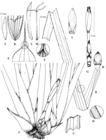Cyperaceae taxon details
Mapania sekudaniana Melana, Shabdin & Meekiong
1817660 (urn:lsid:marinespecies.org:taxname:1817660)
accepted
Species
recent only
Melana I. G. N.; Shabdin, Z.; Ahmad Zahid, A. A. B.; Meekiong, K.; Yeo, F. K. S. (2023). A new sedge species <i>Mapania sekudaniana</> (Cyperaceae) from Sarawak, Malaysia. <em>Malayan Nature Journal.</em> 75: 379-383.
page(s): 380 [details] Available for editors [request]
[request]
page(s): 380 [details] Available for editors
Holotype SAR, geounit Sarawak
Holotype SAR, geounit Sarawak [details]
Description Robust, rhizomatous; rhizome 1.5–2.0 cm diameter. Culms 1 per plant, lateral, 5 x 0.5 cm, terete, glabrous, pinkish brown...
Etymology The epithet is dedicated to Mr Sekudan Anak Tedong in honour of his many years of field assistance for the Mapania project.
LSID urn:lsid:ipni.org:names:77337963-1
Description Robust, rhizomatous; rhizome 1.5–2.0 cm diameter. Culms 1 per plant, lateral, 5 x 0.5 cm, terete, glabrous, pinkish brown to brown. Leaves basal, up to 100 cm long, leaf-blade linear, 56–90 × 3.3–3.5 cm, apex very abruptly narrowed or hooded, the underside of hooded apex appears serrulate toward the apex, base gradually narrowed into sheath, thickly coriaceous, light green to dark green, 3-nerved, secondary nerves indistinct, ± flat in cross-section, indistinct septate nodulose when dry, margins coarsely serrulate; pseudopetiole absent; sheaths lanceolate, 7.5–10 × 2.8–3.0 cm, apex gradually narrowed, coriaceous to thickly coriaceous, cream to light brown to dull green. Cataphylls several, ovate to lanceolate, 5–12 × 1.6–2.2 cm, mid-brown, acute. Inflorescence bracts several, glumaceous, ovate to lanceolate, acute, 1.2–2.3 × 0.7–0.8 cm, greenish brown to dark brown. Inflorescence terminal, oblong lanceolate, 3.8–4.0 × 0.8–1.0 cm, composed of 1 spike, spike remaining obscured by involucral bracts even at maturity, linear, 3.3–3.5 × 1.8–2.1 cm, whitish or light brown, acute, distinct when involucral bracts removed; involucral bract several, glumaceous, oblong lanceolate, 3.4–3.5 × 1.7–1.8 cm, greenish brown, acute, basal bract longest, oblong lanceolate, coriaceous, greenish brown, glabrous, nerves indistinct.spicoid bracts lanceolate, 2.5–2.8 × 3.5–3.9 cm, acute, membranous, whitish or cream, glabrous, nerves indistinct; floral bracts 6, free, lowest 2 bracts narrowly linear, 2.9–3.0 × 0.24 cm, acute, whitish or cream, keel wingless, sparsely hispid, upper bracts narrowly linear, 2.9–3.0 × 0.2 cm, flat glabrous; staminate flowers 3 per spicoid, stamen up to 13 mm long, anthers linear, 12–13 mm long, cream, filaments up to 18 mm long; stigma branches 3; style up to 3 cm long, sparsely hispid. Fruit not seen. [details]
Etymology The epithet is dedicated to Mr Sekudan Anak Tedong in honour of his many years of field assistance for the Mapania project.
Etymology The epithet is dedicated to Mr Sekudan Anak Tedong in honour of his many years of field assistance for the Mapania project. [details]
LSID urn:lsid:ipni.org:names:77337963-1
LSID urn:lsid:ipni.org:names:77337963-1
[details]
[details]
Cyperaceae Working Group. (2025). [see How to cite]. Global Cyperaceae Database. Mapania sekudaniana Melana, Shabdin & Meekiong. Accessed at: https://cyperaceae.org/aphia.php?p=taxdetails&id=1817660 on 2025-09-13
Date
action
by
![]() The webpage text is licensed under a Creative Commons
Attribution 4.0 License
The webpage text is licensed under a Creative Commons
Attribution 4.0 License
Nomenclature
 Present
Present  Inaccurate
Inaccurate  Introduced: alien
Introduced: alien  Containing type locality
Containing type locality
Holotype SAR, geounit Sarawak [details]
Isotype Universiti Malaysia Sarawak, geounit Sarawak [details]
From editor or global species database
Description Robust, rhizomatous; rhizome 1.5–2.0 cm diameter. Culms 1 per plant, lateral, 5 x 0.5 cm, terete, glabrous, pinkish brown to brown. Leaves basal, up to 100 cm long, leaf-blade linear, 56–90 × 3.3–3.5 cm, apex very abruptly narrowed or hooded, the underside of hooded apex appears serrulate toward the apex, base gradually narrowed into sheath, thickly coriaceous, light green to dark green, 3-nerved, secondary nerves indistinct, ± flat in cross-section, indistinct septate nodulose when dry, margins coarsely serrulate; pseudopetiole absent; sheaths lanceolate, 7.5–10 × 2.8–3.0 cm, apex gradually narrowed, coriaceous to thickly coriaceous, cream to light brown to dull green. Cataphylls several, ovate to lanceolate, 5–12 × 1.6–2.2 cm, mid-brown, acute. Inflorescence bracts several, glumaceous, ovate to lanceolate, acute, 1.2–2.3 × 0.7–0.8 cm, greenish brown to dark brown. Inflorescence terminal, oblong lanceolate, 3.8–4.0 × 0.8–1.0 cm, composed of 1 spike, spike remaining obscured by involucral bracts even at maturity, linear, 3.3–3.5 × 1.8–2.1 cm, whitish or light brown, acute, distinct when involucral bracts removed; involucral bract several, glumaceous, oblong lanceolate, 3.4–3.5 × 1.7–1.8 cm, greenish brown, acute, basal bract longest, oblong lanceolate, coriaceous, greenish brown, glabrous, nerves indistinct.spicoid bracts lanceolate, 2.5–2.8 × 3.5–3.9 cm, acute, membranous, whitish or cream, glabrous, nerves indistinct; floral bracts 6, free, lowest 2 bracts narrowly linear, 2.9–3.0 × 0.24 cm, acute, whitish or cream, keel wingless, sparsely hispid, upper bracts narrowly linear, 2.9–3.0 × 0.2 cm, flat glabrous; staminate flowers 3 per spicoid, stamen up to 13 mm long, anthers linear, 12–13 mm long, cream, filaments up to 18 mm long; stigma branches 3; style up to 3 cm long, sparsely hispid. Fruit not seen. [details]Diagnosis Closely similar to Mapania longiflora C.B. Clarke, but distinguishable by its single spike (as opposed to M. longiflora's 3-6 spikes) and abruptly narrowed leaf apex (as opposed to M. longiflora which has gradually narrowed leaf apex). [details]
Ecology Thick humus on sandy clay soil near the stream, especially at Sg. Liku, Lambir Hills National Park, Sarawak. [details]
Etymology The epithet is dedicated to Mr Sekudan Anak Tedong in honour of his many years of field assistance for the Mapania project. [details]
LSID urn:lsid:ipni.org:names:77337963-1
[details]




